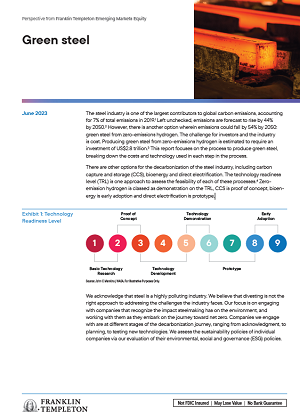The steel industry is one of the largest contributors to global carbon emissions, accounting for 7% of total emissions in 2019. Left unchecked, emissions are forecast to rise by 44% by 2050. However, there is another option wherein emissions could fall by 54% by 2050: green steel from zero-emissions hydrogen. The challenge for investors and the industry is cost. Producing green steel from zero-emissions hydrogen is estimated to require an investment of US$2.8 trillion. This report focuses on the process to produce green steel, breaking down the costs and technology used in each step in the process.
There are other options for the decarbonization of the steel industry, including carbon capture and storage (CCS), bioenergy and direct electrification. The technology readiness level (TRL) is one approach to assess the feasibility of each of these processes. Zero-emission hydrogen is classed as demonstration on the TRL, CCS is proof of concept, bioenergy is early adoption and direct electrification is prototype.
We acknowledge that steel is a highly polluting industry. We believe that divesting is not the right approach to addressing the challenges the industry faces. Our focus is on engaging with companies that recognize the impact steelmaking has on the environment, and working with them as they embark on the journey toward net zero. Companies we engage with are at different stages of the decarbonization journey, ranging from acknowledgment, to planning, to testing new technologies. We assess the sustainability policies of individual companies via our evaluation of their environmental, social and governance (ESG) policies.
Download the full paper
